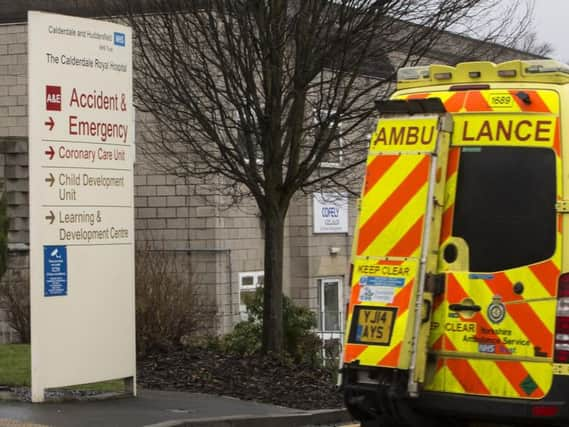Future Calderdale Royal Hospital accident and emergency plan put under the microscope


Calderdale and Kirklees Joint Health Scrutiny Committee also questioned health professionals over issued including bed numbers, development of local health services and funding for the proposals.
Director of Transformation and Partnerships at Calderdale and Huddersfield NHS Foundation Trust, Anna Basford, spoke about the progress report sent to the Secretary of State for Health and Social Care, Matt Hancock, which argues there is “a compelling quality and financial case for change” in the local health system.
Advertisement
Hide AdAdvertisement
Hide AdShe said there was a continuing commitment to retaining numbers of hospital beds while services were being developed in the community until a sustainable reduction in demand for in-hospital patient care could be demonstrated.
Capital funding of £196.6 million had been allocated to support implementation of the proposal.
The report to Mr Hancock says both Huddersfield Royal Infirmary and Calderdale Royal Hospital will both provide 24-hour-a-day consultant-led accident and emergency (A&E) services – but campaigners and councillors quizzed officers about the detail.
The report outlines proposals for Calderdale’s A&E to receive all “blue light” emergency ambulances and all patients likely to require hospital admission and children’s care will also be centres there.
Advertisement
Hide AdAdvertisement
Hide AdHuddersfield A&E would receive self-processing patients with those requiring in-patient admission being transferred by ambulance from Huddersfield – which will have 24-7 anaesthetic cover – to Halifax.
Critical care services, emergency surgical and paediatric surgical services will be at Calderdale while physician led in-patient care will be provided at Huddersfield.
Significant progress was being made in the development and delivery of care closer to home – a model which integrated all primary care, also including community, mental health and social care services, within local community hubs.
Improved local care meant people would not have to go to hospital as often and when they did could return home more quickly.
Advertisement
Hide AdAdvertisement
Hide AdTechnology will be crucial, with the trust aiming to ensure staff and patients have access to the right information and data, at the right time, to help deliver effective, high quality care, says the report.
On proposals for both hospitals, committee chair Calderdale councillor Adam Wilkinson (Lab, Sowerby Bridge) wanted clarity on who would be on call and fellow Calderdale councillor Colin Hutchinson (Lab, Skircoat) asked if resuscitation facilities also extended to children?
Dr David Birkenhead, Executive Medical Director of Calderdale and Huddersfield NHS Trust, said consultants would be on site at Huddersfield during the day and there would be 24-7 specialist medical support.
Expertise would be needed at the Huddersfield site for resuscitation for children if they arrived there.
Advertisement
Hide AdAdvertisement
Hide AdCoun Hutchinson also asked how close the trust was to meeting the guideline of one consultant to every 3,900 attendees.
Mrs Basford said she could not reply specifically but the trust was committed to increasing A&E medical staff numbers at both sites.
Kirklees councillor Liz Smaje (Con, Birstall and Birkenshaw) asked questions relating to proposed changes to local care.
Chief Officer for NHS Greater Huddersfield and NHS North Kirklees Clinical Commissioning Groups, Carol McKenna, said groups of practices would work together with a network which best understood the needs of the population delivering targeted responses.
Advertisement
Hide AdAdvertisement
Hide AdChief Officer of Calderdale CCG, Dr Matt Walsh, said health services would have to respond to changes as they occurred over the next ten years.
He was proud of the changes which were being proposed and Calderdale and Huddersfield NHS Trust was ahead of the game – but it needed to work with partners including local councils.
Coun Hutchinson asked questions about the funding and believed it was important the committee saw the documents prepared for the Secretary of State.
For example, buildings at Calderdale Royal Hospital were not sufficient to deal with the changes and would require major changes.
Advertisement
Hide AdAdvertisement
Hide AdMrs Basford said £177 million had been earmarked for investment into the Calderdale Royal site in Halifax, which needed extensive expansion in a number of areas, with £20 million to be spent at Huddersfield.
With completion of developments still some years away, Coun Wilkinson wanted to know how the trust could be confident a system of care being designed now would be fit for purpose in 2025 and beyond.
Dr Walsh said what the trust had now was “not fit for now” and the aim was to find a sustainable solution. He expected to be involved in conversations about change for the rest of his career.
Coun Hutchinson asked how could the trust know it was on course for a sustainable reduction in beds.
Advertisement
Hide AdAdvertisement
Hide AdDr Walsh said it as the intention to retain the current base of bed numbers until it could be determined otherwise. Integrated care and support to get people home more quickly would reduce need for beds.
Progress locally was being made quickly and he could see need reducing by 40 per cent – more than the 30 per cent official target. It was possible to do.
The committee hears a new process of consultation would start with an upcoming stakeholder event.
Coun Hutchinson asked questions about vascular services, including a shortage of radiologists.
Dr Birkenhead said he would share some of those concerns. The trust was working towards making sure the service is sustainable going ahead.